Published
on 7
Oct 2018
|
All rights reserved.
|
|
|
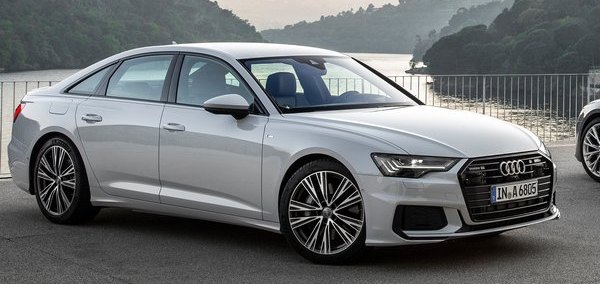
|
|
The
new A6 attempts to beat its rivals with technology, but is it that
simple?
|
|
For
a long time Audi A6, or its predecessor 100 and 200, was seen as a
poorer alternative to Mercedes E-class and BMW 5-Series. People bought
it just because they wanted to be different, or they needed permanent
four-wheel drive. That perception started changing in 1997, and it took
2 or 3 generations to finally make the A6 an equal of its established
rivals. That said, there are still distinctive differences among the
three. Most people say, if you want comfort, choose the Mercedes. If
you want driving excitement, BMW is the unquestionable choice. If you
want style and build quality, Audi is the very best. However, none of
them are resting on their laurels. The latest Mercedes E-class has
already leapfrogged Audi in design and interior. The new BMW 5-Series
has developed a 4WD system that is good enough to put Quattro in shade.
Meanwhile, Audi is hit by brain drain and the ripple effect of
Dieselgate. This means the new A6 has an uphill battle to fight. It
needs to keep its traditional core values. It needs to tackle the
market trend of autonomous driving and sophisticated infotainment
technology. It needs to close the gap from BMW in terms of driving
excitement. It also needs to fulfill the legislation requirements for
reduced emission. All carried out by its somewhat instable development
team.
But one thing is forgotten: styling. From 1997 to 2011, the A6 remained
the best looking executive car in my opinion. That period was also the
golden era of Ingolstadt design, during which the TT and R8 was
created. Those days are over. Talented designers like Peter Schreyer
left the company. Since then Audi design became conservative, always
keeping the same proportion. They just tweak the details here and
there, sometimes more counterproductive than constructive. They handed
the lead to Mercedes.
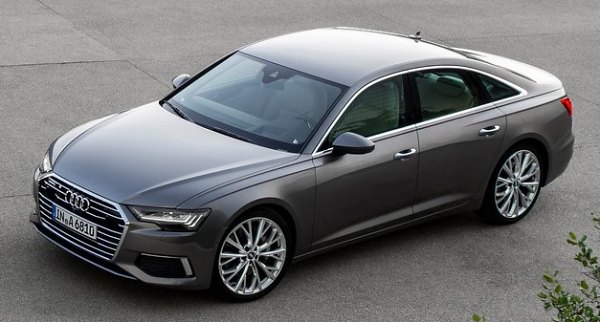 |
|
Slightly
pronounced fenders draw inspiration from Ur Quattro.
|
|
The new A6 is no
exception. Without reading the details, it looks just the same as the
last generation. As for the details, a wider front grille might be a
good idea, as are the slightly pronounced fenders that draw inspiration
from the Ur Quattro, but isn’t the grille, the headlights and the
bumpers too edgy? An E-class wins hearts by its coherence. The Audi
catches attention but ultimately loses admiration by its lack of
coherence. 7 years later, when its designers look back, they might
wonder why they took such an odd direction. Automotive design history
remembers cars as soft as a Jaguar E-Type or as sharp as a Lamborghini
Countach, but an E-Type with a Countach rear wing or scissors doors? No
thanks, because it is not coherent.
Having said that, the A6 is better looking in Avant body than saloon
form. The Avant looks not only smoother but also better balanced,
whereas the saloon feels nose-heavy. Mind you, Audi fits it with
ridiculously large, 21-inch wheels for better visual effect in these
pictures. That would not help ride comfort though, so you had better to
sacrifice a bit of style and opt for 19 or 20-inch items.
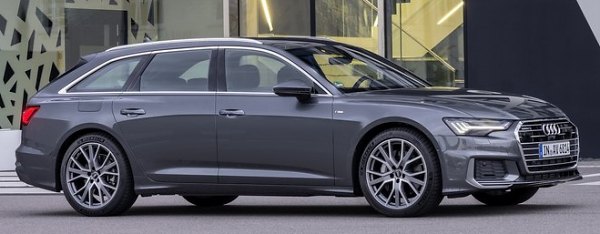
|
|
Avant
body looks better than saloon, thanks to a more balanced proportion.
|
|
The A6 is built on the MLB Evo platform of A4 and A7. It is marginally
longer (+7mm), wider (+12mm) and taller (+2mm) than the outgoing car,
while wheelbase is also slightly longer (+9mm). Drag coefficient is
reduced further from 0.26 to an outstanding 0.24, though available only
on the base model.
Like A4, the chassis is constructed out of primarily steel and
supplemented with a few aluminum structural parts, such as front
suspension strut towers and front bumper beam. However, the larger car
employs many aluminum skins, such as bonnet, boot lid, doors and front
fenders, accompanied with aluminum brake calipers and suspension
components to cut weight. That said, revisiting our report of the last
generation A6 will find the same goodies were already adopted, so the
body-in-white is hardly any lighter. Meanwhile, the addition of 48V
mild hybrid system adds about 25kg, so the whole car is said to be
between 5 and 25 kg heavier than the old one, depending on models. All
engines but the 2.0TDI are equipped with the new 48V mild hybrid
system, which has the 48V lithium battery placed under the boot. 2.0TDI
uses a cheaper but less efficient 12V mild hybrid system. Either case,
a conventional 12V battery is kept to power other electrical devices,
and it is placed in the boot for better balance.
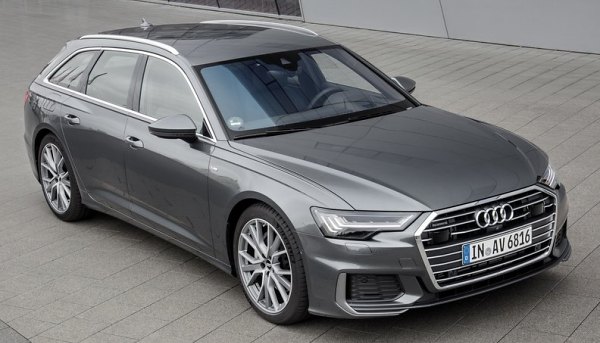 |
|
The
new A6 is no lighter than the car it replaces, blame partly to the
addition of 48V mild hybrid system.
|
|
The chassis is basically the same as that of the A7, so we have not
much to explain. It offers 2 Quattro systems, i.e. Quattro
Ultra for
fuel-saving or the conventional permanent Quattro for the most powerful
diesel. 4-wheel steering is optional, and it is bundled with an active
variable-ratio steering such that when the rear wheels are turning in
the same direction as the front at higher speeds, the front wheels turn
more. There are 4 choices for suspension: standard
setup, sporty setup, adaptive dampers and adaptive air suspension. As
for driving assistance, it carries over from A8, including Level
3-ready autonomous driving (although not many countries allow) and
remote parking by mobile phone. To that end, it employs many cameras,
ultrasonic sensors, mid and long-range radars and a laser scanner to
detect the surrounding.
4 familiar engines are available at launch:
- 3.0TFSI V6 turbo: 340hp / 369 lbft
- 3.0TDI V6 turbo diesel: 286hp / 457 lbft
- 3.0TDI V6 turbo diesel: 231hp / 369 lbft
- 2.0TDI turbo diesel: 204hp / 295 lbft
The 2.0TDI comes from the new EA288 Evo family, producing more power
and employing aluminum block to save weight. Itself and the 3.0TFSI are
mated with 7-speed S tronic gearbox, while both diesel V6s employ
8-speed ZF automatic.
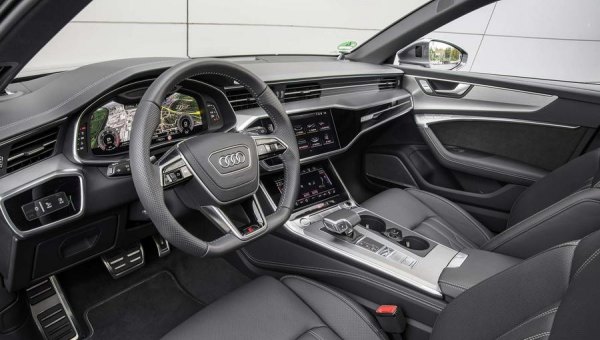
|
|
Twin-touchscreen
sacrifices some practicalities for showroom appeal. |
|
Shared with A7, the interior design sells on a high-tech theme. There
is Audi Virtual Cockpit digital instrument up front and a center
console occupied by twin-touchscreen. Build quality and material
richness are just as you would expect for Audi. Space is also generous,
as it offers 17mm more rear legroom and 10mm more headroom than the old
car.
However, is the twin-touchscreen layout really an advancement? Slick
and cool-looking it might be, more practical it is not. The 10.1-inch
upper screen is used to display infotainment, while the 8.6-inch lower
screen is for climate control. Wait, why do you need a touchscreen
instead of some easy-using rotary knobs to control air-conditioning?
The MMI Touch system offers haptic feedback on touch, but there is some
delay, and it is not as easy to operate as the old MMI rotary switch
when the car is moving. Moreover, the glass surfaces catch up
fingerprints easily. Audi sacrifices some practicalities for showroom
appeal.
To drive, the A6 does not disappoint, nor it is surprising. Put it
straight, this car demonstrates the core values of Audi without
breaking ground in any particular areas. The engines? V6 petrol is
smooth and responsive, V6 diesel is gusty and refined, and even the
4-cylinder diesel is quite good. All of them lack the tuneful exhaust
note of the old supercharged V6, but a subdued manner is suitable to a
luxury car. Refinement? Excellent, it is free of wind and mostly road
noises.
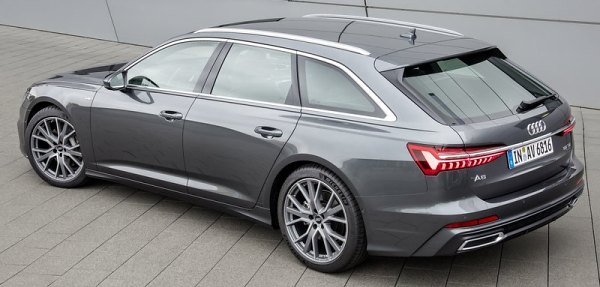
|
|
4WS
adds agility, but its response is inconsistent and unnatural.
|
|
Ride quality? If you can avoid the largest wheels, it ranges from
excellent on highway to acceptable on broken pavements, certainly
smoother than A7, but no match for an E-class or to lesser extent the
5er. Air suspension handles its imbalanced weight better, but the
leanest 2.0TDI with passive suspension is actually the smoothest of the
bunch. It is also the best to steer. All A6 models have their body
movement nicely controlled and understeer suppressed reasonably well.
They all lack steering feel though, just as the tradition of Audi, but
the 4-cylinder car carries significantly less weight at the nose thus
it is keener to steer and its chassis response is more consistent. 4WS
helps the nose-heavy V6 cars to feel more agile than they have any
rights to be, especially at low speed in urban area. Still, it is no
driver’s car. Inconsistent steering load and non-progressive turning
rate result in an unnatural driving experience. This means, while
standard Quattro offers good grip and traction, you are not encouraged
to exploit its chassis.
The A6 is still a credible choice in the executive car segment. Choose
it and you are unlikely to be disappointed. However, this generation
fails to edge closer to the territory of its German rivals in the areas
it is the weakest, i.e. ride comfort and driving pleasure. Meanwhile,
it fails to keep the lead in the areas it has been leading for long,
i.e. styling and interior. Yes, it is very sophisticated – even
complicated, but the technologies have yet to be put to good use. The
result is less than the sum of its components. What a pity.
|
Verdict:     |
Published
on 30
May 2019
|
All rights reserved.
|
|
Audi S6 TDI
|
|
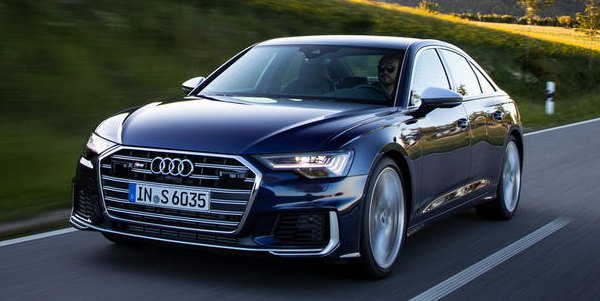
|
|
Driven
by the need to reduce emission, even the S6 has to turn to diesel
power. Does it compromise?
|
|
Remember what engine the
original S6 employed? A classic 2.2-liter 5-cylinder turbo. Then it got
bigger and bigger, more and more powerful, from 4.2-liter V8, 5.2-liter
V10 to the most recent 4.0-liter twin-turbo V8. Few performance cars
could enjoy such a wide range of engine configurations. However, the
latest S6 seems to be taking a step backward. Not only its engine is
downsized to a 3-liter V6 turbo, but it has switched to diesel power
for the first time, at least in European market. That is really
surprising, especially when you consider Audi has its reputation
damaged seriously in the Dieselgate scandal, during which its CEO
Rupert Stadler was arrested and dismissed. Diesel is losing popularity
in Europe as a result, and some European cities even ban diesel cars
from urban area. Why does Audi buck the trend? I suppose it faces
strong pressure to cut its fleet emission, otherwise could face heavy
fines. Like it or not, legislations have a big impact to what kind of
cars we can drive. Even a performance car like the S6 is no exception.
America does not have regulations so strict, so the American version of
S6 will get a more conventional 3-liter twin-turbo V6 petrol, something
similar to the RS4 and RS5.
I remember the first time the phrase “performance diesel” came into my
mind was the reveal of Volkswagen 5-liter V10 turbo diesel. That mega
engine produced 313 horsepower and 553 pound-foot of torque,
unprecedented numbers. However, these days a 3-liter V6 turbo is good
enough to out-power, if not exactly out-torque, the old V10. The 3.0
TDI here produces 349 hp and 516 lbft, some 63 hp and 59 lbft more than
the most powerful version of 3.0 TDI on A6. How is this possible? By
using a bigger turbo with higher boost pressure. How to deal with the
resultant turbo lag? By adding an electric charger, powered by a 48V
mild-hybrid system which can be recharged from coasting and
deceleration. This technology was pioneered by Audi SQ7 4.0TDI a couple
of years ago. It is now transferred to the smaller engine.
However, in terms of power, the V6 TDI is no match for the last petrol
twin-turbo V8. That engine produced 100 horsepower more, enabling the
outgoing S6 to do 0-60 in 4.2 seconds. The new S6 TDI is significantly
slower at 4.8 seconds. Moreover, even in the diesel world, it is hardly
the leader. In fact, BMW has been selling M550d since 2012. Its
tri-turbo straight-six produced even more power than the new Audi, and
its latest incarnation, equipped with no fewer than 4 turbos, achieves
a neat 400 horsepower, accompanied with 560 lbft of torque. That car
does 0-60 sprint in a staggering 4.2 seconds. What the Audi does excel
is emission, which is rated at 164g/km, versus the BMW’s 171g/km. This
has to thank its mild-hybrid system. That said, whether the small
advantage in emission can offset the giant gap in performance is
another matter.
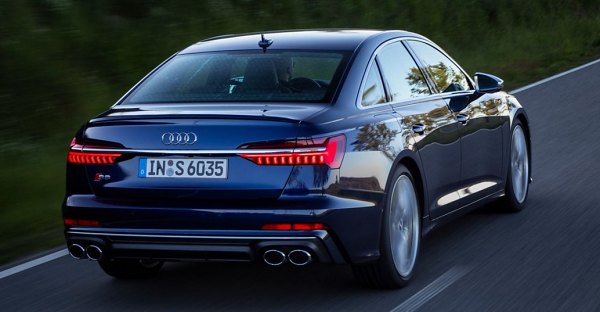
|
|
Keep
it in its power band between 2000 and 3500 rpm and you will enjoy a
blend of elastic performance and superb refinement.
|
|
On the road, the TDI engine sounds better than you can expect for a
diesel, although this is mostly due to the artificial noise
orchestrated by the sound system. At least, it is remarkably refined,
doesn’t clutter or vibrate. On the downside, despite the use of an
electric charger, power delivery seems a bit leisure at low revs. It is
not particularly responsive before the big turbo kicks in. It refuses
to rev as eagerly at the top end as M550d either, as peak power is
produced at a modest 3850 rpm instead of its rival’s 4400 rpm. However,
keep it in its power band between 2000 and 3500 rpm and you will enjoy
a blend of elastic performance and superb refinement. It feels like a
big V8.
The ZF 8-speed automatic gearbox shifts smoothly, if not as quickly as
the 7-speed twin-clutch of the old car. The Quattro system with 40:60
crown-gear differential provides dependable traction all the time. The
S6 is very heavy at 1955 kg. You can feel its weight in trickier roads,
but its optional 4WS system mostly hides the bulk well. Sometimes it
may even feel over-aggressive in low-speed maneuvering, thus the
calibration of the rear-wheel steering has space for improvement.
Likewise, the adaptive air springs may fail to iron out challenging
roads. On faster roads, the S6 feels at home, delivering a smooth and
stable ride, while the body movement is tightly controlled. The
steering is nicely weighted and geared, if not particularly
communicative.
The S6 TDI is a nice try to break from the established formula. As a
daily driver, it is not a bad choice, especially if you value its
impeccable interior and electronics technology high. However, there are
just better options from BMW and, if you live outside Europe, the S6
itself. There is not much wrong with the 3.0 TDI engine, but the 100
extra horsepower offered by the petrol twin-turbo V6 is simply
impossible to
resist.
|
Verdict:    |
Published
on 16
Apr 2020
|
All rights reserved.
|
|
Audi S6
|
|
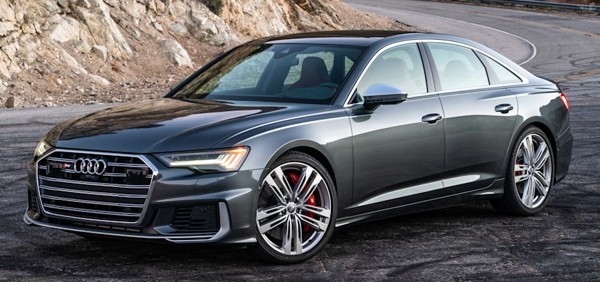
|
|
Not
as frugal as S6 TDI, but its much wider power band is far more
satisfying to access.
|
|
If you have not read the S7 review yet, read it first, because it
contains more information about the new twin-turbo and electric
supercharged 2.9-liter V6 that is shared with this car. In short, Audi
has done all it can to minimize the drawback of downsizing from V8 to
V6, but there are still some inevitable negative effects, such as a
less exciting noise, slightly more lag and slower acceleration. The
latter is due to replacing the outgoing twin-clutch gearbox with an
8-speed automatic transmission. The new S6 is good for 0-60mph in 4.4
seconds, up 2/10ths from the old V8 model. However, thanks to also
using mid-hybrid tech, it is considerably less thirsty. Not as
fuel-sipping as the European S6 TDI, but it is much quicker and its
much wider power band is far more satisfying to access.
As always, we prefer the A6 to its A7 sibling for its extra
practicality, especially in this case the price difference is so big –
$75K vs $85K in the USA. Both cars are practically the same underneath
their different clothes. While the S7 certainly looks more beautiful,
it is not especially fun to drive in the context of a coupe. In
contrast, the refined and understated manner of Audi suits more the S6.
It is also a tad quicker, thanks to 50kg less weight.
|
Verdict:    |
Published
on 18
Feb 2020
|
All rights reserved.
|
|
Audi RS6
|
|
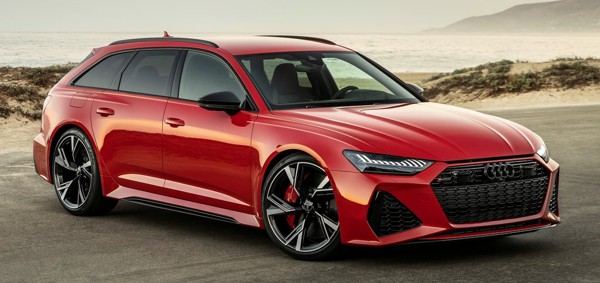
|
|
An
all-rounder, but not necessarily the most fun to drive.
|
|
There are no fundamental
differences separating the new and old Audi RS6 Avant. The only
distinctive change is appearance. While the old car (as well as its
predecessors) followed the school of Q-car, looking too civilized and
understated in my eyes, the new car has injected a lot more aggression,
most notably at the nose and tail. Tasteful? I am not sure. Beautiful?
Certainly not, but it does catch more eyes on the road. From now on,
everybody can tell that it is an RS6 instead of an S6, which is good to
justify the huge price gap. The RS6 costs as much as £100,000
with a few much-needed options, whereas the S6 is a relative bargain at
£57,000.
The problem is, the new RS6 is again available with Avant body only. It
might be clever to avoid direct competition with the class-leading BMW
M5, which is saloon-only, but Mercedes-AMG offers both body styles to
its E63, and the latter is hardly any slower, less well built or more
expensive. The competition among M5, E63 and RS6 will never end.
Just like the current A6, the RS6 has an interior that is both
sophisticated and impeccably built. Space is generous both front and
rear, while the Avant's load bay is capacious. However, also up is the
kerb weight, which rises from 1935 to an alarming 2075 kg, despite more
extensive use of aluminum in its construction. Note that M5 Competition
and E63 S are both 200 kg lighter. Even the E63 Wagon is 80 kg less.
That makes a difference in real-world performance.
Part of the weight gain is attributed to the new 48V mild-hybrid
system. It adds a starter-generator and an additional lithium battery,
because Audi has yet to upgrade the 12V electrical system that powers
the rest of the car. On the plus side, the additional battery is placed
under the boot, so to help balancing the car a little. It goes without
saying the mild-hybrid system recoups energy from braking and uses it
for assisting acceleration, or lets the engine to shut down during
coasting. It doesn’t help performance much, but it is essential to help
the entire Volkswagen group to meet CO2
target. Everybody pays the price for polluting the earth, but the
buyers of heavyweight high-performance cars deserve to pay more.
The 4.0-liter twin-turbo V8 is a development from the old car. Its long
list of technology finally stops growing, i.e. hot-V architecture,
twin-scroll turbos, direct injection, 10:1 compression, plasma spray
iron coating on cylinder bore and cylinder deactivation by Audi
Valvelift mechanism. However, Audi enlarges its turbos and ups its
boost pressure from 1.2 to 1.4 bar, lifting output from 560 hp to 600
hp. Peak torque increases from 516 to 590 lbft. Mind you, the old RS6
Performance was even more powerful at 605 hp, but it couldn’t match the
new car for torque. Expect the next Performance will squeeze out even
more.
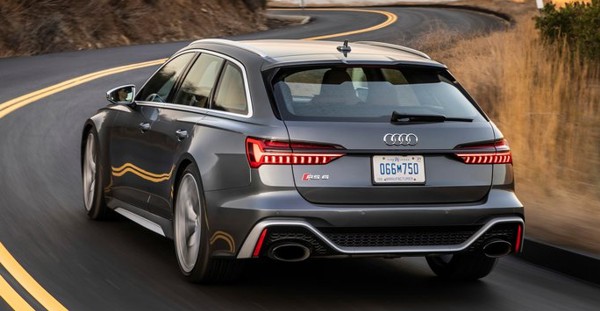
|
|
You
may even induce a little oversteer at corner exit with a big prod of
throttle, something unimaginable on the RS6 of yesteryears.
|
|
Thanks to 600 horsepower, the seamless shift of ZF 8-speed automatic
and the Quattro system, the RS6 sprints from 0-60 mph in merely 3.5
seconds and flats out at a regulated 190 mph. Fast? Unquestionably. The
fastest performance sedan or wagon? Probably not. A few years ago Audi
could still use its advantage in 4-wheel traction to outrun its rivals.
Now both AMG and BMW have switched to 4WD, so you will find the M5
Competition and E63 S are even faster, achieving 0-60 in 3.2 and 3.3
seconds, respectively. As speed rises beyond 100 mph, their power and
weight advantages will continue to dominate, leaving the Audi a distant
third.
The Audi V8 is also less raucous than AMG V8, if not BMW's. It is
generally a calm, refined and efficient motor. With optional sport
exhaust fitted, there is more satisfying growl at wide open throttle,
or some crackles on overrun, but in normal driving it is just quiet and
smooth. You sense the speed from vision rather than sound. As a Q-car,
it is successful. Probably too successful, because it deceives also the
driver.
The Quattro system uses crown-gear center differential to deliver 60
percent torque to the rear wheels normally, or up to 85 percent if the
front wheels slip. That said, it is still a pure mechanical, passive
setup, unlike the electronically controlled active torque split of its
rivals. To recoup the lost ground, the RS6 employs an active rear
differential, variable-ratio steering as well as 4-wheel
steering.
On the road, these translate to a good handling. For a car so big and
heavy, it turns in keenly, feeling quite nimble, especially at lower
speeds where the rear wheels steer in opposite direction. The steering
lacks feel, as expected for an Audi, but it is quick and precise.
Understeer is a thing of the past, as the new car resists it strongly.
It feels mostly neutral, and you can trust the traction and grip from
the 285/30ZR22 tires. You may even induce a little oversteer at corner
exit with a big prod of throttle, something unimaginable on the RS6 of
yesteryears. The new RS6 is unquestionably a very quick point-to-point
car, but ultimately it still feels heavier and less interactive to
drive as its BMW and AMG rivals.
That is based on the car equipped with optional DRC (Dynamic Ride
Control) suspension. Like the last generation, the RS6 offers 2
suspension options. The standard one employs air springs and adaptive
dampers. It is set 20mm lower than the regular A6, and its ride height
is adjustable and adaptive to speed. This is supposed to be the choice
of comfort, but the air suspension is not necessarily competent of
dealing with poor surfaces. This makes the DRC option a no-brainer. It
employs conventional steel springs but the adaptive dampers are
diagonally interconnected by hydraulic (i.e. front right wheel to rear
left wheel; front left wheel to rear right wheel). Just as we found out
on the old car, DRC exhibits better body control and sharper response,
thanks to the lack of air cushioning. In contrast, the RS6 equipped
with air suspension feels softer riding, less precise in its body
control and less connected to the road.
The RS6 is also distinguishable from those widened wheel arches. They
are used to accommodate the huge 22-inch wheels, which are designed to
house the optional, 440 mm ceramic brake discs (“pizza-size discs” is
an understatement here). They provide the stopping power required by
the heavyweight machine, but pedal feel is not quite as linear as
standard steel items, especially when cold. Just like its brakes, the
RS6 feels overcomplicated yet slightly compromised for sheer driving
pleasure. While itself is an all-rounder, its rivals are simply purer,
faster and more fun to drive.
|
Verdict:     |
Published
on 20
Jul 2023
|
All rights reserved.
|
|
Audi RS6 Performance
|
|
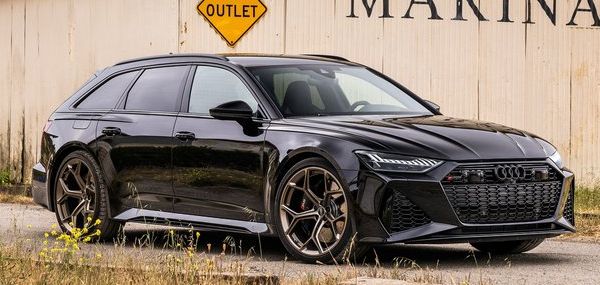
|
|
The
highlight of Performance is not the small power boost but those mega
wheels, which do wonder to its handling.
|
|
As before, the Performance
label is the swan song of Audi RS6. It arrives at the last part of its
lifecycle and dials everything up to 10. Unfortunately, that includes
its price, too, which is now £130,000 before options. That puts
it in
the territory of the very best BMW M5 CS. However, since the RS6
Performance is strictly in Avant body, its closest rivals might be
Mercedes-AMG E63 S Wagon.
Changes made to the Performance model are subtle but pretty effective.
The V8 motor gains slightly larger turbine wheels to lift boost
pressure from 1.4 to 1.6 bar, resulting in 630 hp and 627 lbft, or an
increase of 30 hp and 37 lbft. 0-60 mph is cut a two-tenths to 3.3
seconds – though still no match for the 2.9 seconds of M5 CS. On the
road, it is hard to tell the extra punch without comparing the
Performance and regular RS6 side by side, but you will immediately
notice more induction noise from the driver seat, because Audi has
removed 8 kg of insulation materials from the firewall. While the
regular RS6 has been criticized for too quiet in action, the
Performance sounds a fair bit more exciting, even though it is still
more retrained than its AMG and BMW counterparts.
The RS6 was also criticized for a tad too soft in handling. The
Performance model keeps all the essential hardware intact, including
the Quattro system, 4-wheel steering, active rear differential, the
option of air suspension or DRC (steel springs and hydraulically
interconnected damping) and optional ceramic brakes. The crown-gear
mechanical center differential gets smaller and lighter, but its
characteristics are unchanged. What really improves its ride and
handling are smaller things: the new 22-inch Y-spoke forge-milled alloy
wheels are 5 kg lighter each piece, meaning a saving of 20 kg of
unsprung weight. The new Continental SportContact 7 tires offer a
little bit more grip in both dry and wet conditions without sacrificing
quietness. The operating modes of adaptive suspension have been
recalibrated to offer bigger differences. The 8-speed automatic gearbox
has been reprogrammed to shift a tad quicker.
These changes might sound minor, but the combined effect is
surprisingly good: the RS6 Performance feels more responsive and more
agile. While the electrical power steering itself is unaltered, the
lighter front wheels and stickier rubber transfer some true feel to the
steering wheel, answering our biggest criticism to the standard car.
Although the Performance isn’t quite as pointy as the M5 CS due to the
mass hanging at its nose, it does feel more responsive to turn than the
standard car. Understeer is virtually non-existent, at least on road.
Yes, it could have been made sharper, rawer and more exciting still,
but Audi doesn’t
want to blunt its ability as a luxury highway cruiser. The Performance
sacrifices almost no refinement and comfort. It is still a very good
luxury car to travel long distances, even though those mega wheels look
otherwise.
Problem is, you might expect more from £130,000, like the step
change from M5 to M5 CS. The Performance is what the RS6 should have
been from the outset, not an upgrade we have been waiting for so long.
It is probably too late and too little, because the next generation M5
and performance version of i5 are just around the corner. Some
potential customers may cross-shop Porsche Taycan Cross Turismo Turbo,
which is quicker and sounds more the future.
|
Verdict:     |
|